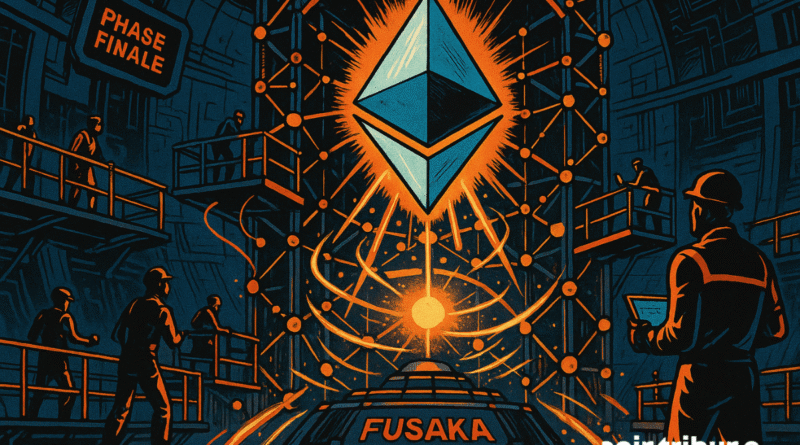Ethereum is entering its final phase before a historic turning point
Summarize this article using:
Ethereum is preparing for a decisive step in its technical overhaul. As the rollout of Fusaka nears, the network is entering the final testing phase of a key update. But behind this discrete change lies a strategic inflection point: laying the groundwork for parallel execution, expected in 2026. More than just a performance boost, Ethereum is embarking on a structural transformation designed to sustainably support its rise in the face of growing scalability challenges.
In short
- The Fusaka update is entering its final testing phase before its mainnet deployment scheduled for December 3, 2025.
- It imposes a gas limit per transaction set at 16.78 million units to prevent a single transaction from monopolizing an entire block.
- A per-transaction limit enables better resource allocation, reduces DoS risks and improves block predictability.
- This update prepares for the arrival of parallel transaction execution, planned for 2026 with the Glamsterdam update (EIP-7928).
New limit for more stability
The Fusaka update introduces a major innovation: the establishment of a gas cap per transaction set at 16.78 million units in accordance with the EIP-7825 proposal.
Until now, a single transaction could consume all the available gas in a block, around 45 million units, putting the network at risk of congestion or Denial of Service (DoS) attacks. The per-transaction gas limit aims to improve block efficiency, reduce DoS risks, and lay the foundation for parallel execution.
This restriction is already active on the Holesky and Sepolia test networks as part of the preparatory phases for deployment on the main network.
By setting this limit, Ethereum aims to improve the resilience of the protocol while streamlining transaction processing. This technical change is accompanied by an increase in the total capacity of the blocks, which varies from 45 to 60 million units of gas.
Specifically, this development enables:
- Prevent a single transaction from monopolizing the resources of an entire block;
- Support the simultaneous inclusion of several lower-intensity transactions;
- Reduce the risks of saturation or targeted attacks on gas consumption;
- Optimize block construction predictability for validators and developers.
This redesign of the inner workings of the network represents a key step in professionalizing the Ethereum infrastructure with future developments such as parallel execution in mind.
From testnets to mainnet to massive parallel execution
In addition to this new block architecture, Fusaka introduces a central innovation called PeerDAS for “ Sampling the availability of equivalent data ». This system allows Ethereum nodes to store only a random part of the data “drop” from layers 2, not the entire dataset.
The goal is to reduce hardware requirements while maintaining network security. This advancement aims to boost the adoption of rollup solutions that rely on this very data availability. In fact, this PeerDAS innovation “reduces hardware requirements while maintaining security and enables more cost-effective, high-throughput scalability for Layer 2 networks”.
The implementation of PeerDAS paves the way for the next step in Ethereum’s roadmap: the update “Glam Amsterdam”expected in 2026, which will introduce EIP-7928, the first concrete iteration of parallel transaction execution. This development will make it possible to process several operations simultaneously, instead of performing them sequentially, as is still the case today.
From this point of view, Fusaka acts as a basic premise: without gas limits per transaction or a data-optimized infrastructure, parallel execution could not be deployed safely. To Gabriel Trintinalia, Engineer at Consensys,“These testnet updates are necessary to build trust before the mainnet fork”.
Ultimately, this series of improvements, scheduled for December 3rd, could profoundly transform the inner workings of Ethereum. The network is moving towards a more modular architecture, more scalable and better suited for future use, especially layer two solutions. They allow to verify performance, identify borderline cases and refine technical parameters before activation.
Maximize your Cointribune experience with our “Read and Earn” program! Earn points for every article you read and get access to exclusive rewards. Register now and start reaping the benefits.
A graduate of Sciences Po Toulouse and holder of the blockchain consultant certification issued by Alyra, I joined the Cointribune adventure in 2019. Convinced of the potential of blockchain to transform many sectors of the economy, I committed myself to raising awareness and informing the general public about this ever-evolving ecosystem. My goal is to enable everyone to better understand blockchain and take advantage of the opportunities it offers. I strive every day to provide an objective analysis of current events, decipher market trends, convey the latest technological innovations, and put into perspective the economic and social issues of this ongoing revolution.
DISCLAIMER OF LIABILITY
The comments and opinions expressed in this article are solely those of the author and should not be considered investment advice. Before making any investment decision, do your own research.
